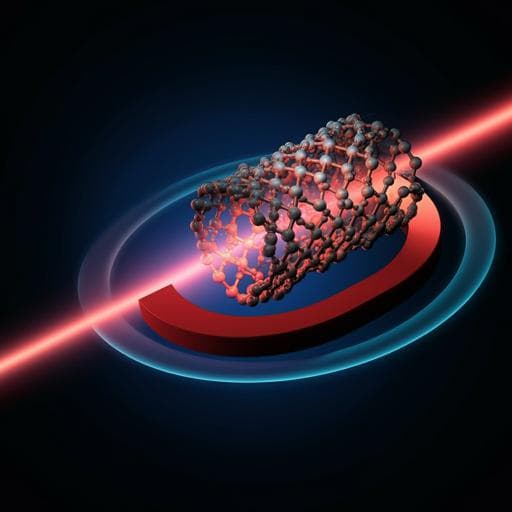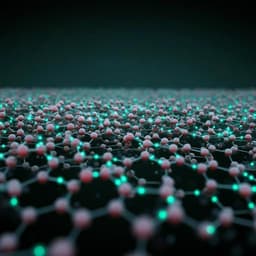
Physics
Nanotube spin defects for omnidirectional magnetic field sensing
X. Gao, S. Vaidya, et al.
Discover the groundbreaking potential of optically addressable spin defects in boron nitride nanotubes, showcasing a unique spin S = 1/2 state that enables versatile magnetic field sensing in any orientation. This research by Xingyu Gao and colleagues suggests innovative applications in atomic-scale quantum sensing.
~3 min • Beginner • English
Introduction
The study addresses whether one-dimensional van der Waals nanotubes can host optically addressable spin defects suitable for quantum sensing with omnidirectional magnetic field sensitivity. Conventional solid-state spin sensors such as diamond nitrogen-vacancy centers and boron vacancy defects in hexagonal boron nitride (hBN) are spin S = 1 systems with large zero-field splitting and fixed quantization axes, rendering them less sensitive to off-axis magnetic fields and challenging to use near surfaces. Zero-dimensional quantum dot spins have short room-temperature lifetimes. The authors propose boron nitride nanotubes (BNNTs) as a robust 1D host lacking dangling bonds, enabling nanoscale tips for scanning probe magnetometry. They aim to discover and characterize single spin defects in BNNTs, determine their spin properties (including the presence or absence of zero-field splitting), demonstrate orientation-independent ODMR suitable for omnidirectional sensing, and showcase applications including sensing anisotropic magnetization in a 2D magnet and scanning-probe magnetometry.
Literature Review
Prior work established optically active spin defects in 3D diamond (NV centers) enabling nanoscale sensing but with fabrication complexity and degraded properties near surfaces. In 2D hBN, ensembles and single optically active defects, notably negatively charged boron vacancies (V−), have enabled wide-field imaging of 2D magnets but are diffraction-limited and are S = 1 systems with large ZFS, causing reduced ODMR contrast for off-axis fields. TR12 centers in diamond and other solid-state spins have explored vector magnetometry. Electron spin qubits in quantum dots require cryogenic operation due to short lifetimes at room temperature. Carbon nanotube spins have been observed via transport or conventional EPR at low temperatures, but ODMR of localized spin defects in nanotubes had not been achieved. BNNTs possess a large bandgap (~6 eV) and host quantum emitters; reports exist of stable emission in BNNTs, but not of room-temperature ODMR of localized defects suitable for sensing. This work positions BNNT spin defects as filling this gap by enabling ODMR with S = 1/2 ground-state character and near-zero ZFS for omnidirectional sensing.
Methodology
- Sample and probe preparation: Commercial BNNTs (average diameter ~50 nm, length a few micrometers) were dispersed in ethanol, sonicated, and spin-coated onto Si. To increase spin-defect yield, BNNTs were irradiated by 2.5 keV ionized CO2 at a dose of 1e13 cm−2 and annealed at 1000 °C for 2 h at ~1e−5 Torr. Yields increased from ~5% of bright emitters showing ODMR (as-received) to ~20–30% after treatment. BNNTs were either placed on substrates (gold stripline, samples) or picked up and attached to AFM cantilever tips for scanning probe configurations.
- Optical and microwave setup: A home-built confocal microscope with a 532 nm laser (AOM-switched), 0.9 NA 100× objective, dichroic and long-pass filtering, and single-photon counting was used. Microwaves were generated (SG386), amplitude-modulated by fast RF switches, amplified (ZHL-10W-202S or ZHL-16W-43-S+), and delivered via on-chip gold striplines. ODMR was performed in both CW and pulsed modes. A permanent magnet on translation and goniometer stages supplied tunable fields and allowed rotation of field orientation.
- CW ODMR characterization: PL spectra and second-order correlation g(2)(τ) established single defects (g(2)(0) < 0.5) with an excited-state lifetime 1.8 ± 0.3 ns. ODMR spectra were recorded versus out-of-plane magnetic fields from 13 to 98 mT; resonance frequency versus field was fitted to extract g-factor and zero-field splitting (ZFS). Orientation dependence tests rotated the external magnetic field around two orthogonal axes while keeping laser and MW powers fixed, monitoring resonance frequency, contrast, and linewidth.
- Pulsed ODMR and spin dynamics: Rabi oscillations were measured using resonant MW pulses of varying durations after optical initialization; spin-lattice relaxation T1 was measured via pump–wait–probe sequences; spin coherence time was measured via pulsed sequences (reported ~110 ns; details in Supplementary).
- Sensing anisotropic magnetization in a 2D magnet: BNNTs with spin defects were transferred onto regions of a Fe3GeTe2 (FGT) flake and onto adjacent gold striplines on the same chip. Temperature-dependent ODMR was performed in a cryostat with liquid N2 cooling. Local fields Bloc were inferred from ODMR frequency fODMR via Zeeman splitting. The stray field from FGT was obtained by subtracting the background measured on gold: Bs = (fODMR,FGT − fODMR,Au)/γμB. Measurements were performed with external magnetic fields applied out-of-plane and in-plane.
- Scanning probe magnetometry: A BNNT-attached AFM cantilever (nanotube protruding several micrometers) was positioned within a few hundred nanometers above patterned nickel structures on a MW waveguide. Without closed-loop feedback, the sample was scanned under the fixed probe, recording ODMR spectra at each pixel to build 2D stray-field maps (pixel size 500 nm) and 1D line scans (step size 40 nm). Stray fields were computed relative to the minimum field in the scanned area and compared to simulations (Supplementary).
Key Findings
- First observation of single optically addressable spin defects in BNNTs at room temperature showing ODMR. An example CW ODMR spectrum at Bext = 26 mT shows a resonance at 735 MHz with ~26 MHz linewidth and positive ODMR contrast.
- Single-photon emission confirmed with g(2)(0) < 0.5; excited-state lifetime 1.8 ± 0.3 ns.
- Resonance frequency varies linearly with magnetic field: g = 2.000 ± 0.004 with negligible zero-field splitting (ZFS < 10 MHz), indicating an S = 1/2 ground state without an intrinsic quantization axis.
- Orientation independence: Rotating the magnetic field around two orthogonal axes leaves ODMR resonance frequency unchanged and ODMR contrast/linewidth nearly constant (minor contrast changes attributed to MW field geometry), enabling omnidirectional magnetic sensing.
- Coherent control: Clear Rabi oscillations observed; spin-lattice relaxation time T1 ≈ 14 μs nearly independent of field orientation; spin coherence time ~110 ns.
- Anisotropic magnetization sensing in Fe3GeTe2: At 300 K the ODMR frequencies on FGT and gold are similar (negligible Bs). At 90 K (below TC ≈ 220 K), frequency difference of 88.7 MHz corresponds to Bs ≈ 3.2 mT. Temperature-dependent measurements show increased Bs below ~220 K for out-of-plane fields, while with in-plane fields the stray field near the edge remains nearly constant, demonstrating strong magnetic anisotropy.
- Scanning probe magnetometry: BNNT-on-cantilever probe maps stray fields over nickel patterns. 2D maps (500 nm pixels) and 1D line scans (40 nm steps) show resonance shifts consistent with simulations, including clear shifts when crossing 600 nm-wide features.
- Sensitivity: Typical DC magnetic field sensitivity ~80 μT/Hz on gold striplines; best observed 21 μT/Hz; BNNT-on-cantilever probe sensitivity ~245 μT/Hz limited by lower count rate and contrast. BNNTs are mechanically robust and suitable for contact-mode sensing.
- BNNT dimensions: average diameter ~50 nm; nanotube protrusion of several micrometers aids photon collection.
Discussion
Demonstrating single spin defects in BNNTs with negligible ZFS and g ≈ 2 establishes a new class of S = 1/2, optically addressable spin sensors that lack an intrinsic quantization axis. This property allows the spin quantization to align with any applied magnetic field direction, making the Zeeman splitting depend only on field magnitude and yielding orientation-independent ODMR frequency, contrast, and linewidth under suitable MW drive. Consequently, BNNT spin defects can detect magnetic fields omnidirectionally with nearly uniform sensitivity, overcoming a key limitation of S = 1 systems like diamond NV and hBN VB− centers, which lose contrast for off-axis fields due to large ZFS. The authors validated omnidirectional performance by rotating the magnetic field and observing invariant resonance frequencies and nearly constant contrast, and further leveraged this to probe anisotropic magnetization in Fe3GeTe2, resolving out-of-plane versus in-plane responses that would be challenging for NV sensors. By integrating BNNTs onto AFM cantilevers, the work demonstrates scanning-probe ODMR beyond the optical diffraction limit, showing robust operation and agreement with simulations over patterned nickel structures. The absence of ZFS also reduces susceptibility to temperature and strain drifts, improving sensing robustness. Overall, the results position BNNT spin defects as versatile sensors suitable for nanoscale and potentially atomic-scale magnetometry in arbitrary field geometries.
Conclusion
The work discovers and characterizes single, optically addressable spin defects in boron nitride nanotubes exhibiting S = 1/2 ground-state behavior with negligible zero-field splitting and g = 2.000 ± 0.004. These defects provide orientation-independent ODMR, enabling omnidirectional magnetic field sensing with consistent sensitivity. The authors demonstrate applications including direct measurement of anisotropic magnetization in Fe3GeTe2 and scanning-probe magnetometry using BNNT-attached cantilevers to map stray fields over nickel patterns. BNNT probes are mechanically robust, cost-effective, and resilient against environmental perturbations due to the lack of ZFS, offering advantages over nanofabricated diamond tips and other sensors. Reported DC sensitivities range from ~80 μT/Hz typically to 21 μT/Hz best, with current cantilever probes at ~245 μT/Hz. Future work should focus on improving photon collection and ODMR contrast, implementing feedback to reduce probe–sample spacing for nanometer-scale resolution, identifying and engineering the defect species (likely carbon-related), increasing defect yield and stability, and exploring contact-mode and in situ biological sensing, as well as coupling to nanotube mechanics for quantum transduction.
Limitations
- Defect identification: The precise microscopic structure of the BNNT spin defect is not resolved; evidence suggests carbon-related centers after CO2 implantation, but definitive assignment is pending.
- Yield and variability: Only a small fraction (~5%) of bright emitters in as-received BNNTs show ODMR; post-implantation yield improves to ~20–30%. ODMR contrast and photon rates vary between defects, impacting sensitivity.
- Scanning setup constraints: The scanning-probe system lacks feedback stabilization, limiting probe–sample distance control to a few hundred nanometers and pixel sizes to ~500 nm, which constrains spatial resolution.
- Sensitivity limits: The BNNT-on-cantilever probe exhibits reduced sensitivity (~245 μT/Hz) due to lower count rates and contrast compared to on-chip configurations.
- Minor orientation dependencies in contrast can arise from MW field geometry even though the resonance frequency is orientation independent.
- Generalizability to different environments (e.g., fully in vivo or high-noise settings) is suggested but not experimentally demonstrated here.
Related Publications
Explore these studies to deepen your understanding of the subject.







